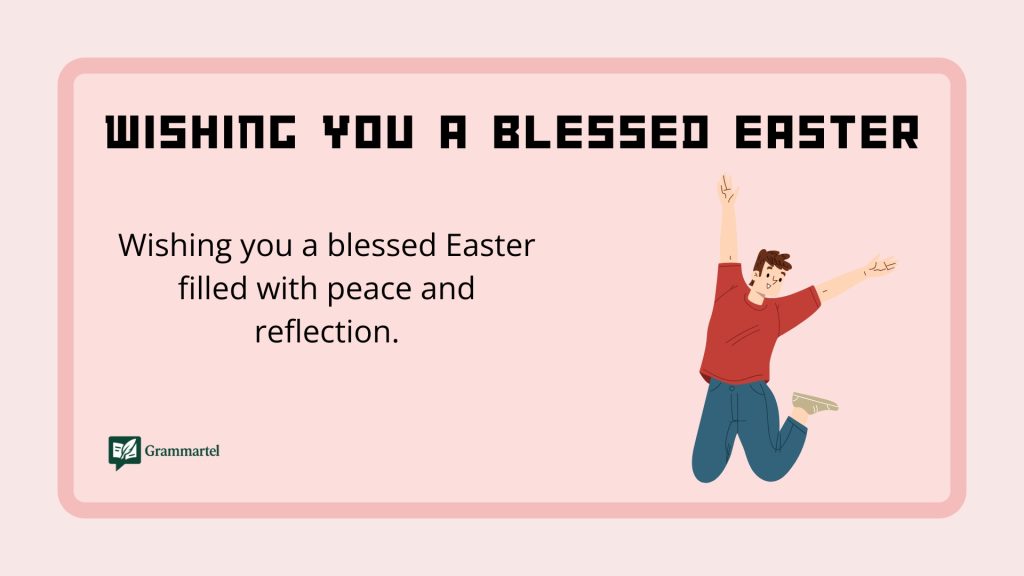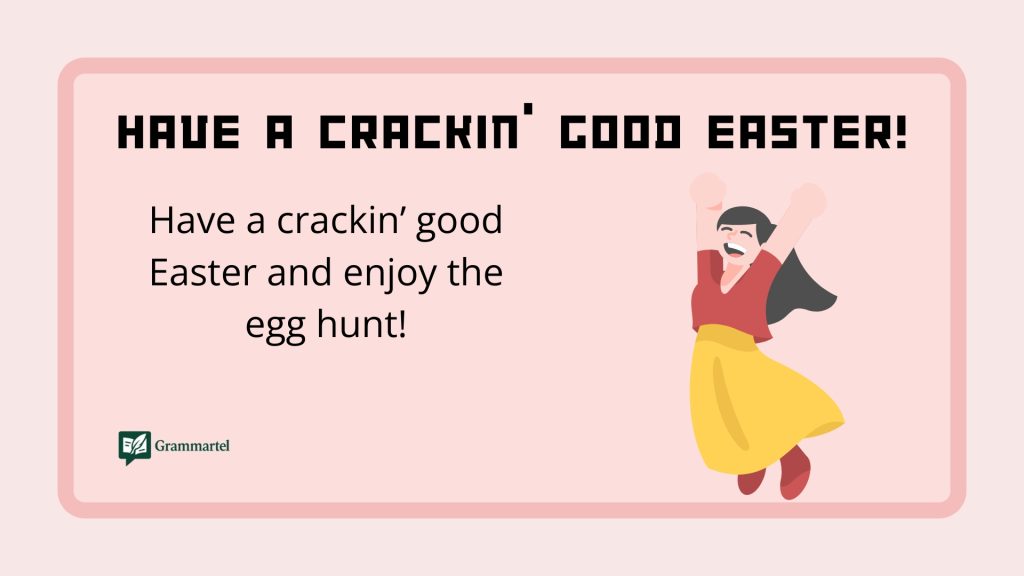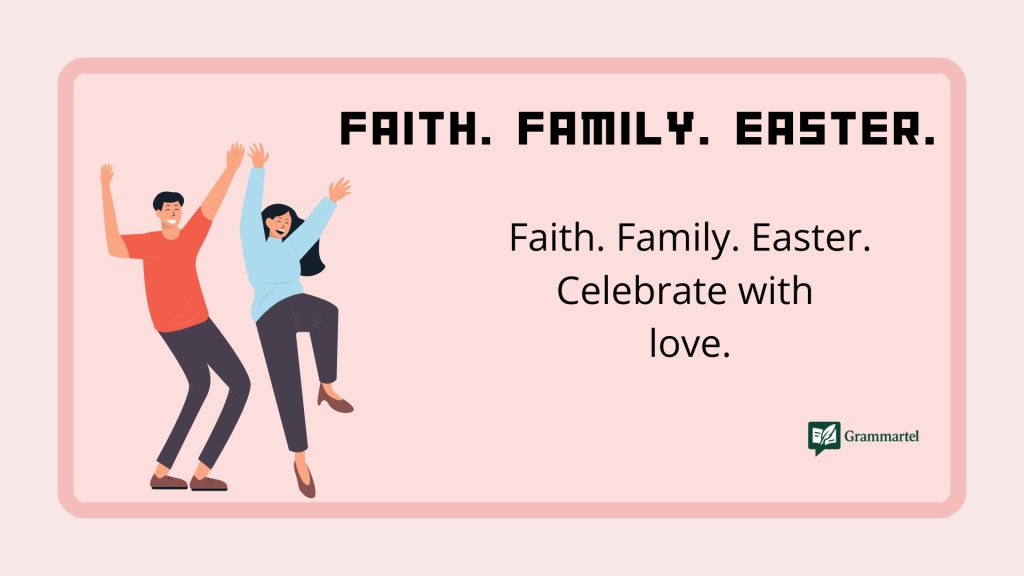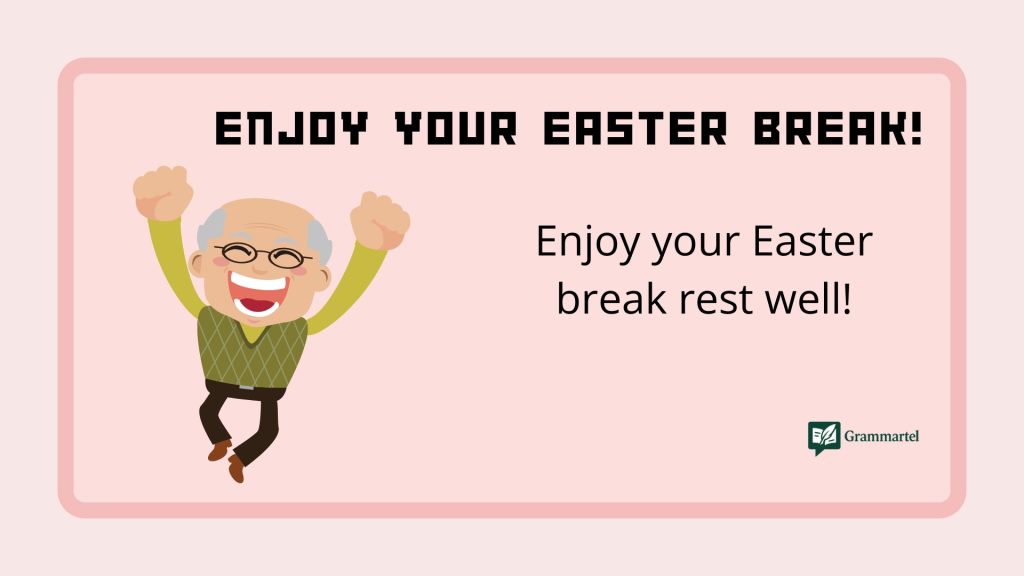Easter is more than chocolate bunnies and colorful eggs—it’s a time to share love, hope, and kindness. Whether you’re writing a card, sending a quick message, or posting something special online, finding the right words can make someone’s day brighter. A heartfelt Easter wish can remind your friends and family how much they mean to you. So, if you’re looking for ways to say “Happy Easter” that feel personal and warm, you’re in the right place.
What Does “Happy Easter” Mean?
“Happy Easter” is a kind greeting people say on Easter Sunday. Easter is a Christian holiday that celebrates the resurrection of Jesus Christ. It is a time of joy, hope, and new life. Many people also celebrate with fun traditions like egg hunts, chocolate bunnies, and spending time with family.
When someone says “Happy Easter,” they are wishing you a joyful and peaceful day. It is a way to spread kindness and good feelings.
When to Use “Happy Easter”
You can say “Happy Easter” a few days before Easter, on Easter Sunday, and even the day after. Most people say it when greeting others on Easter or in cards and messages.
You can use it in person, over the phone, in texts, or on social media. It’s a warm and friendly way to join the celebration. Just make sure the person you are speaking to celebrates Easter, so they feel respected.
40 Heartfelt Ways to Say “Happy Easter”
1. Happy Easter!
Meaning: A standard greeting for Easter.
Explanation: Simple and widely used.
Example: “Happy Easter! Hope you have a joyful day with your family.”
Best Use: In cards, texts, or in-person greetings.
Worst Use: In formal business emails unless there’s context.
Tone: Cheerful, neutral
2. Wishing you a blessed Easter

Meaning: A spiritual or religious wish for Easter.
Explanation: Focuses on the holy nature of the holiday.
Example: “Wishing you a blessed Easter filled with peace and reflection.”
Best Use: For religious friends or family.
Worst Use: In secular workplaces.
Tone: Reverent, thoughtful
3. Have a joyful Easter!
Meaning: A wish for happiness on Easter.
Explanation: Highlights the emotional aspect of the celebration.
Example: “Have a joyful Easter! Enjoy the sunshine and time with loved ones.”
Best Use: Personal messages or social media.
Worst Use: When discussing sensitive topics.
Tone: Uplifting, lighthearted
4. Easter blessings to you and yours
Meaning: Sending spiritual well-wishes for Easter.
Explanation: Traditional and often used in religious contexts.
Example: “Easter blessings to you and yours this Sunday.”
Best Use: In religious cards or sermons.
Worst Use: Among non-religious acquaintances.
Tone: Warm, spiritual
Read next : 40 Better Ways to Say “Excited to Join the Team” (With Examples).
5. He is risen!
Meaning: A Christian proclamation of Jesus’ resurrection.
Explanation: Core message of Easter Sunday.
Example: “He is risen! May your faith be renewed this Easter.”
Best Use: Among practicing Christians.
Worst Use: Among secular audiences or interfaith settings.
Tone: Devotional, emphatic
6. Happy Resurrection Day
Meaning: A more theological version of Happy Easter.
Explanation: Emphasizes Jesus’ resurrection.
Example: “Happy Resurrection Day to all celebrating!”
Best Use: In Christian communities.
Worst Use: Among secular or interfaith groups.
Tone: Religious, celebratory
7. Enjoy your Easter weekend!
Meaning: A casual wish for a good long weekend.
Explanation: Non-religious and general.
Example: “Enjoy your Easter weekend! Hope it’s relaxing.”
Best Use: Work emails or texts.
Worst Use: Deeply religious conversations.
Tone: Friendly, informal
8. Hope the Easter Bunny is good to you!
Meaning: A playful wish related to Easter traditions.
Explanation: Refers to the Easter Bunny bringing candy/gifts.
Example: “Hope the Easter Bunny is good to you this year!”
Best Use: With kids or playful adults.
Worst Use: In serious or religious discussions.
Tone: Fun, whimsical
9. Wishing you renewal this Easter
Meaning: A metaphorical hope for personal growth.
Explanation: Ties into spring themes of rebirth.
Example: “Wishing you renewal and peace this Easter.”
Best Use: For reflective or personal messages.
Worst Use: In very casual settings.
Tone: Thoughtful, serene
10. Have a hoppy Easter!
Meaning: A pun on “Happy” with reference to bunny hops.
Explanation: Light and humorous Easter greeting.
Example: “Have a hoppy Easter! Don’t eat too much chocolate.”
Best Use: With kids or close friends.
Worst Use: Formal situations.
Tone: Playful, humorous
11. May your Easter basket overflow with joy.
Meaning: A wish for abundant happiness.
Explanation: Fun play on the Easter basket tradition.
Example: “May your Easter basket overflow with joy and chocolate!”
Best Use: Holiday cards, kid-friendly messages.
Worst Use: Business memo.
Tone: Playful, sweet
12. Wishing you peace and renewal this Easter.
Meaning: Highlights Easter’s themes of rebirth and serenity.
Explanation: Suitable for spiritual or secular greetings.
Example: “Wishing you peace and renewal this Easter weekend.”
Best Use: Cards, emails, wellness messages.
Worst Use: Humor-based content.
Tone: Calm, reflective
13. Celebrate the miracle of Easter.
Meaning: Honors the religious aspect of the holiday.
Explanation: Perfect for faith-centered messages.
Example: “Celebrate the miracle of Easter with faith and love.”
Best Use: Religious gatherings.
Worst Use: Non-religious audiences.
Tone: Reverent, spiritual
14. Have a crackin’ good Easter!

Meaning: Pun on cracking eggs.
Explanation: Light and humorous.
Example: “Have a crackin’ good Easter and enjoy the egg hunt!”
Best Use: Casual chats, social posts.
Worst Use: Church newsletter.
Tone: Funny, casual
15. Joyful Easter wishes to you!
Meaning: Straightforward, heartfelt greeting.
Explanation: Suitable in almost any setting.
Example: “Joyful Easter wishes to you and your family!”
Best Use: All-purpose greeting.
Worst Use: Intense theological discussion.
Tone: Warm, neutral
16. May your heart bloom this Easter.
Meaning: A poetic springtime metaphor.
Explanation: Combines themes of Easter and nature.
Example: “May your heart bloom this Easter with kindness and love.”
Best Use: Greeting cards, romantic notes.
Worst Use: Dry, factual contexts.
Tone: Poetic, emotional
17. Let the joy of Easter fill your soul.
Meaning: Spiritual and emotional depth.
Explanation: Good for meaningful or reflective messages.
Example: “Let the joy of Easter fill your soul and spirit.”
Best Use: Religious texts, thoughtful cards.
Worst Use: Party invitations.
Tone: Deep, spiritual
18. Easter cheer to you and yours!
Meaning: A cheerful, friendly greeting.
Explanation: A bit old-fashioned but charming.
Example: “Easter cheer to you and yours!”
Best Use: Group greetings, older audiences.
Worst Use: Teen text message.
Tone: Cheerful, classic
19. Spring blessings and Easter joy.
Meaning: Combines seasonal and spiritual themes.
Explanation: Blends the sacred and secular nicely.
Example: “Sending spring blessings and Easter joy your way.”
Best Use: Greeting cards.
Worst Use: Dry professional setting.
Tone: Balanced, warm
20. Hope you find all the eggs and none of the calories!
Meaning: Humorous Easter pun.
Explanation: Great for health-conscious friends.
Example: “Hope you find all the eggs and none of the calories this Easter!”
Best Use: Social media, fitness friends.
Worst Use: Formal audience.
Tone: Light, cheeky
21. Celebrate Easter with hope in your heart.
Meaning: Focus on internal renewal.
Explanation: Encourages reflection.
Example: “Celebrate Easter with hope in your heart and joy in your steps.”
Best Use: Thoughtful messages.
Worst Use: Quick texts.
Tone: Inspiring, gentle
22. He is risen—hallelujah!
Meaning: A proclamation of Christ’s resurrection.
Explanation: Classic religious Easter exclamation.
Example: “He is risen—hallelujah! Let’s celebrate this victory of life!”
Best Use: Easter sermons, Christian cards.
Worst Use: Secular greetings.
Tone: Triumphant, spiritual
23. Bunny kisses and Easter wishes!
Meaning: Cute and affectionate.
Explanation: Perfect for children or romantic partners.
Example: “Bunny kisses and Easter wishes for you!”
Best Use: Family, kids, couples.
Worst Use: Professional contacts.
Tone: Sweet, whimsical
24. Wishing you a renewal of spirit.
Meaning: Encourages personal rejuvenation.
Explanation: Deep and adaptable to all beliefs.
Example: “Wishing you a renewal of spirit and strength this Easter.”
Best Use: Wellness, mindfulness communities.
Worst Use: Casual joke greeting.
Tone: Reflective, uplifting
25. Don’t put all your eggs in one basket—but enjoy Easter anyway!
Meaning: Humor mixed with wisdom.
Explanation: A light-hearted message with a nod to an old saying.
Example: “Don’t put all your eggs in one basket—but enjoy Easter anyway!”
Best Use: Friends, social media.
Worst Use: Formal communications.
Tone: Witty, informal
26. Faith. Family. Easter.

Meaning: A succinct, powerful greeting.
Explanation: Speaks to the heart of many Easter traditions.
Example: “Faith. Family. Easter. Celebrate with love.”
Best Use: Religious posts, family cards.
Worst Use: Corporate settings.
Tone: Strong, concise, spiritual
27. Hallelujah, it’s Easter!
Meaning: Joyful religious exclamation.
Explanation: Great for enthusiastic believers.
Example: “Hallelujah, it’s Easter! Let’s rejoice in His promise.”
Best Use: Easter church announcements.
Worst Use: Non-religious crowd.
Tone: Bold, celebratory
28. Here comes Peter Cottontail!
Meaning: Reference to the classic Easter bunny.
Explanation: Playful and nostalgic.
Example: “Here comes Peter Cottontail—Happy Easter!”
Best Use: Kids, fun events.
Worst Use: Serious religious contexts.
Tone: Playful, nostalgic
29. Let every sunrise remind us of His resurrection.
Meaning: Poetic spiritual imagery.
Explanation: Links nature with faith.
Example: “Let every sunrise remind us of His resurrection and promise.”
Best Use: Church bulletins, Christian blogs.
Worst Use: Secular forums.
Tone: Poetic, reverent
30. Have an eggs-traordinary Easter!
Meaning: Classic pun on “extraordinary.”
Explanation: Light and egg-themed fun.
Example: “Wishing you an eggs-traordinary Easter!”
Best Use: Casual chats, family messages.
Worst Use: Formal communication.
Tone: Punny, cheerful
31. A joyful Easter and a bright spring ahead!
Meaning: Combines Easter and seasonal hope.
Explanation: Good transition greeting.
Example: “Wishing you a joyful Easter and a bright spring ahead!”
Best Use: Cards, emails.
Worst Use: Theology debates.
Tone: Optimistic, light
32. Enjoy the rebirth of hope this Easter.
Meaning: Reflects symbolic new beginnings.
Explanation: Tied to both spiritual and seasonal themes.
Example: “Enjoy the rebirth of hope this Easter and always.”
Best Use: Personal letters.
Worst Use: Kids’ greetings.
Tone: Hopeful, serious
33. Celebrate Easter with love and chocolate.
Meaning: Lighthearted mix of sweetness and affection.
Explanation: Perfectly balances fun and sentiment.
Example: “Celebrate Easter with love and chocolate—you deserve both!”
Best Use: Friends and family.
Worst Use: Strictly religious messages.
Tone: Sweet, playful
34. Wishing you sunshine, smiles, and lots of jellybeans!
Meaning: Whimsical and bright.
Explanation: Kid-friendly and lighthearted.
Example: “Wishing you sunshine, smiles, and lots of jellybeans this Easter!”
Best Use: Young kids, family messages.
Worst Use: Somber reflections.
Tone: Fun, casual
35. Easter: A time to believe again.
Meaning: Encourages renewed faith or hope.
Explanation: Thoughtful and motivational.
Example: “Easter: A time to believe again in what matters.”
Best Use: Reflections, speeches.
Worst Use: Easter egg hunt posters.
Tone: Inspirational
Don’t miss : 40 Heartfelt Alternatives to Say “I Miss You” (With Real-Life Examples).
36. Celebrate new life this Easter.
Meaning: General expression of Easter’s theme.
Explanation: Applies to both secular and sacred observances.
Example: “Celebrate new life this Easter and every day.”
Best Use: Spring or Easter messages.
Worst Use: Joke-centered exchanges.
Tone: Sincere, balanced
37. Have a colorful and cheerful Easter!
Meaning: Embraces the vibrant joy of the season.
Explanation: Appeals visually and emotionally.
Example: “Have a colorful and cheerful Easter filled with fun!”
Best Use: Cards, kids’ greetings.
Worst Use: Religious sermon.
Tone: Bright, upbeat
38. May the promise of Easter fill your heart.
Meaning: Refers to Easter’s hope-filled meaning.
Explanation: Subtle but powerful religious tone.
Example: “May the promise of Easter fill your heart with peace.”
Best Use: Christian audiences.
Worst Use: Non-observers.
Tone: Meaningful, devotional
39. Enjoy your Easter break!

Meaning: Casual nod to the holiday period.
Explanation: Not specific to religious observance.
Example: “Enjoy your Easter break—rest well!”
Best Use: Schools, workplaces.
Worst Use: Church messages.
Tone: Neutral, relaxed
40. Hippity hoppity Easter’s on its way!
Meaning: Nostalgic Easter bunny reference.
Explanation: Fun and singsong in tone.
Example: “Hippity hoppity Easter’s on its way—get your baskets ready!”
Best Use: Kids, Easter event promos.
Worst Use: Serious reflections.
Tone: Silly, festive
Conclusion
No matter how you say it, a kind Easter message can bring a smile to someone’s face. It doesn’t have to be fancy—just honest and thoughtful. Whether it’s for a friend, a coworker, or someone far away, these messages help you share joy and remind others they’re in your thoughts. So go ahead—pick one that feels right, or make it your own. Easter is all about love, after all.
Achieve faster, more polished writing with Grammartel.

